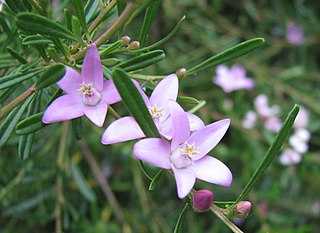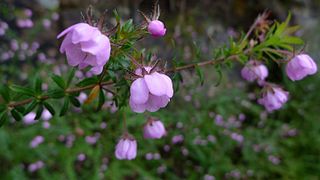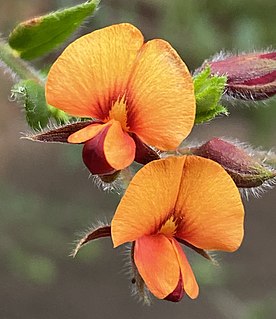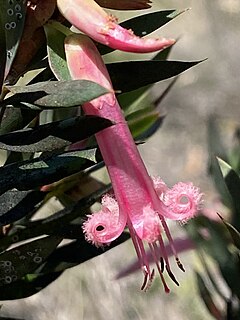
Hibbertia, commonly known as guinea flowers, is a genus of flowering plants in the family Dilleniaceae. They are usually shrubs with simple leaves and usually yellow flowers with five sepals and five petals. There are about 400 species, most of which occur in Australia but a few species occur in New Guinea, New Caledonia, Fiji and Madagascar.

Hakea salicifolia commonly known as the willow-leaved hakea, is species of flowering plant that is endemic to eastern Australia. It is an adaptable, fast growing small tree or shrub with attractive foliage and cream white flowers.

Crowea is a genus of small evergreen shrubs in the family Rutaceae, sometimes known as waxflowers. There are three species and many subspecies and cultivars, all of which are popular as ornamentals because of their abundant, attractive flowers which often occur during autumn and winter. Crowea species are all endemic to Australia, where they occur in Victoria, New South Wales and Western Australia.

Crowea exalata, commonly known as small crowea or waxflower, is a flowering plant in the family Rutaceae and is endemic to the states of Queensland, New South Wales and Victoria in Australia. It is an attractive small shrub and is a popular garden plant. It flowers mainly from late summer to mid-winter when few others are flowering but usually has some flowers at other times of the year.

Bauera is a genus of four species of flowering plants in the family Cunoniaceae, all endemic to eastern Australia. Plants in the genus Bauera are shrubs with trifoliate leaves arranged in opposite pairs and have flowers with four to ten sepals and four to ten white or pink petals.

Correa alba, commonly known as white correa, is a species of shrub that is endemic to south-eastern Australia. It has egg-shaped to more or less circular leaves, erect white flowers arranged singly or in groups on short side branches, and green fruit.

Bauera rubioides, commonly known as river rose, dog rose or wiry bauera, is a species of flowering plant in the family Cunoniaceae and is endemic to south-eastern Australia. It is a scrambling, tangled shrub with wiry branches, trifoliate, usually toothed leaves, and pink or white flowers.

Phebalium stenophyllum, commonly known as narrow-leaved phebalium, is a species of small shrub that is endemic to south-eastern Australia. It has scaly branchlets, narrow oblong to more or less cylindrical leaves and yellow flowers in umbels of three to ten.

Myoporum parvifolium, commonly known as creeping boobialla, creeping myoporum, dwarf native myrtle or small leaved myoporum is a plant in the figwort family, Scrophulariaceae. It is a low, spreading shrub with long, trailing stems and white, star-shaped flowers and is endemic to southern Australia including Flinders Island.

Thomasia quercifolia, commonly known as oak leaved thomasia, is a flowering plant in the family Malvaceae. It has oak-like leaves and mauve-pink flowers and is endemic to the south-west of Western Australia.

Persoonia linearis, commonly known as the narrow-leaved geebung, is a shrub native to New South Wales and Victoria in eastern Australia. It reaches 3 m (9.8 ft), or occasionally 5 m (16 ft), in height and has thick, dark grey papery bark. The leaves are, as the species name suggests, more or less linear in shape, and are up to 9 cm (3.5 in) long, and 0.1 to 0.7 cm wide. The small yellow flowers appear in summer, autumn and early winter, followed by small green fleshy fruit known as drupes. Within the genus Persoonia, it is a member of the Lanceolata group of 58 closely related species. P. linearis interbreeds with several other species where they grow together.

Daviesia ulicifolia, commonly known as gorse bitter-pea, is a species of flowering plant in the family Fabaceae and is endemic to south-eastern Australia. It is a rigid, openly-branched shrub with sharply-pointed, narrow elliptic, narrow egg-shaped, rarely egg-shaped phyllodes and usually orange-yellow and dark red flowers.

Commersonia dasyphylla, commonly known as kerrawang, is a species of flowering plant of the family Malvaceae and is endemic to eastern continental Australia. It is a shrub with egg-shaped to lance-shaped with irregular edges and flowers in groups of up to 21, followed by hairy brown capsules.

Mirbelia rubiifolia, commonly known as heathy mirbelia, is a species of flowering plant in the family Fabaceae and is endemic to eastern Australia. It is a diffuse, spreading shrub with narrowly egg-shaped to linear, sharply-pointed leaves and clusters of pink to purple flowers.

Eriostemon australasius commonly known as pink wax flower is a plant in the citrus family Rutaceae and is endemic to eastern Australia. It is an erect, bushy shrub with narrow oblong leaves and pink flowers with five petals in late winter and early spring.

Baeckea brevifolia is a species of flowering plant in the family Myrtaceae and is endemic to south-eastern New South Wales. It is a shrub with narrow egg-shaped to oblong leaves and white to pink flowers with nine to fifteen stamens.

Styphelia viridis, commonly called green five corners, is a plant in the family Ericaceae and is endemic to the east coast of Australia. It owes its common name to the appearance of its fruit - a drupe with a flat top and five distinct ribs, and to the colour of its flowers. The flowers appear in autumn and winter and are a source of food for honeyeaters.

Acacia iteaphylla, commonly known as Flinders Range wattle, Port Lincoln wattle, winter wattle and willow-leaved wattle, is a shrub belonging to the genus Acacia and the subgenus Phyllodineae that is endemic to South Australia.

Oxylobium cordifolium, commonly known as the heart-leaved shaggy pea, is a species of flowering plant in the family Fabaceae and is endemic to New South Wales. It is a small, prostrate shrub with long, wiry branches, heart-shaped leaves and orange-red flowers.

Styphelia triflora, commonly known as pink five-corners, is a flowering plant in the heath family Ericaceae. It is an erect, spreading shrub with broad leaves with a spiky tip, and usually pink tubular flowers with the petals rolled back. It is found in New South Wales and Queensland growing on loam or sandy soils.



















